How to Build and Manage a Product Team Distributed Across 11 Countries, Jakob Knutzen, CEO of Butter
Butter is a platform designed to help you engage your participants and provide interactive collaboration for those conducting online workshops, training sessions, and live courses.
Unlike other online platforms out there, Butter boasts “all the required tools” you need to prepare your entire workshop in advance. At your fingertips, you have: a preset agenda, breakouts, polls, and much more to help you run collaborative and interactive sessions.

We provide companies with senior tech talent and product development expertise to build world-class software. Let's talk about how we can help you.
Contact usJakob Knutzen, Co-founder and CEO of Butter, shares the pros and cons to building and managing a global team, Butter’s approach to outsourcing, how to find a ‘diamond’ in the rough, and how founders often get bogged down in ‘fake work’—impairing the possibility of success.
Table of Contents
A slice of Butter’s history: How did Butter come to life?
Over a year and a half ago, while working on a product completely separate from Butter, Jakob and his now co-founders were hosting online seminars with the goal of teaching people how to properly engage listeners on a virtual call. This was in responseto Covid forcing the whole workforce to adapt to the new reality of remote working.
They quickly realised the limits of virtual platforms like Zoom and Teams when conducting these seminars and saw an opportunity to produce a product that makes online interaction considerably more engaging—therefore equalling better productivity, work fluidity, and a higher quality form of business communication.
Many companies were saved by platforms such as Zoom and Teams at the beginning of Covid, which makes it difficult to imagine working from home without them. However, these platforms are perhaps a temporary option, as they weren’t designed for advanced collaboration—lacking the digital-first experience one would expect.
While working on a game streaming business that didn’t take off, the now three co-founders realised that they had a connection and amazing personality mix that could not be ignored. Jakob describes the trio as the hacker, the hipster, and the hustler. Chris, CPO—the hipster, Adam, CTO—hacker, and Jakob, who is in charge of product development, sales, and marketing, would have to call himself the hustler.
The Butter Team: Managing a team across 11 countries
“Butter is a completely online business with a workforce of 18 employees stretched across 11 countries. Many people talk about the difficulty of working remotely, but I believe that the real problem is that the entrance hurdles to remote collaboration are greater than the obstacles to working in a room full of people and expecting them to contribute.”
Working remotely, according to Jakob, requires more precision and intentionality. There are a lot of rules and regulations that must be followed. For example, he has extremely strict rules on how to communicate with each other on Slack or on making sure all decisions and the reasons for them are documented in order to achieve a greater level of transparency.
When it comes to working remotely, Jacob and his team view it as an opportunity—and one that isn’t nearly as tough to do, especially for them, being passionate gamers. He believes that it’s one of the best ways to connect and cultivate bonds online without ever meeting face-to-face.
“A systematic set-up for coffee discussions would be necessary if you wanted to do it offline. As a result, many of these items must be constructed from the ground up, using a more deliberate approach. You’re compelled to be more efficient, and naturally better than an offline company from the very beginning once you have it up and running.”
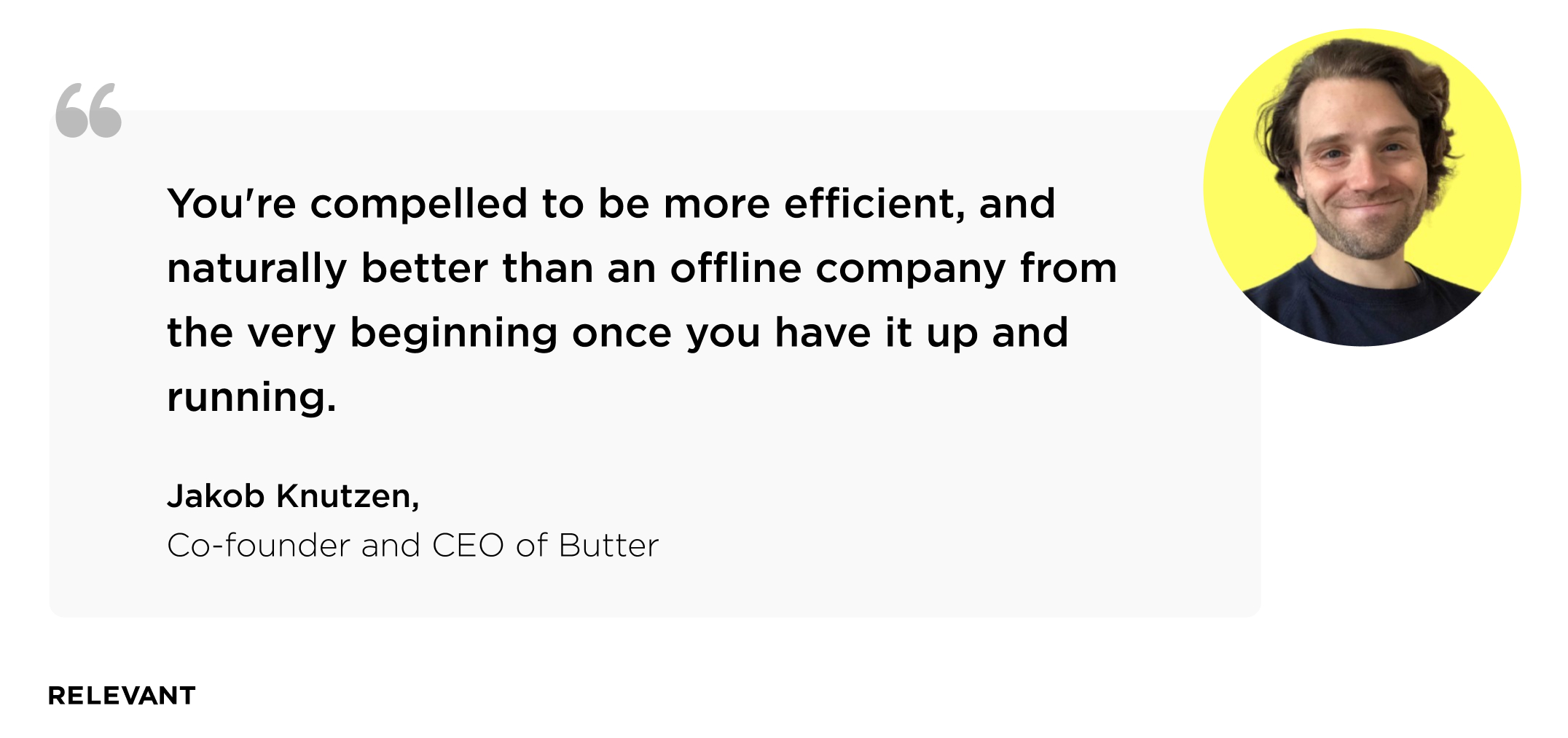
Hiring: Who and how to hire when you have the world at your fingertips
A benefit and drawback of working for a remote firm is the ability to hire new employees from all around the world. Jakob amusingly explains that it’s great because you have the whole world to choose from, but at the same time, you have the whole world to choose from. Sometimes such a huge pool of talent can make it, in a way, harder to find a suitable candidate for your company.
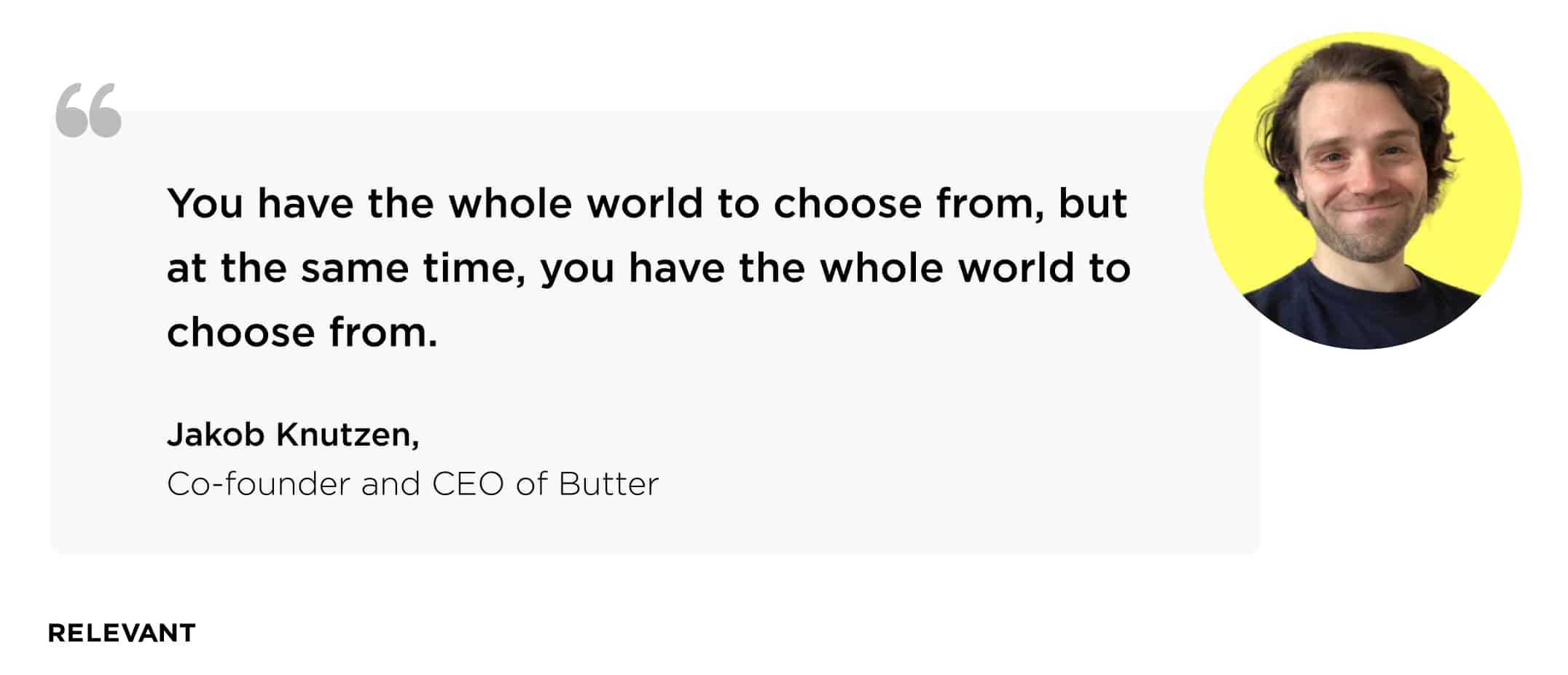
The Butter team has created a detailed set of guidelines to follow when it comes to hiring new employees. Many of the employees on the development team are from Europe and Asia. African and Southeast Asian countries have recruitment personnel already set up ready to scoop the fresh talent from these regions.
“A lot of cold outreach is done on LinkedIn, typically targeting employees of unicorns or other high-performing firms, or on remote work and job board sites. We had a hard time comprehending it at first, because, how do you get the whole globe to join? It’s been a big help to us to identify these important regions where exceptional talent can be found.
Star Countries: Where to find diamonds in the rough
“I really love this concept of the diamond in the rough—finding amazing people in places you wouldn’t expect. For instance, I lived in Indonesia for two and a half years and that’s a country of around 250 million. It’s the fourth-biggest country in the world. Sadly, the education system is not up to high standards, but there are still some absolutely extraordinary individuals that find their way through that education system, almost in spite of it. They teach themselves how to code, or whatever skills they need to learn. Nigeria is a similar case, being Africa’s most populous country, it’s packed with so much great skill and talent. These areas have been the two big surprises for us. We have also reached out to the more traditional geographies, such as India, which is a well-known geography to recruit from, but also Portugal.”
The interview process
“It’s hard to find the ‘diamonds’ from a resume perspective. But it’s not necessarily hard to spot them once you get them in the hiring process. It is just about announcing that openness, both to the world, but also to yourself and to your team that these are your values.”
“One of the other ways we’re finding this talent is by asking candidates to fill out a questionnaire when applying for the role. We’ve got also some slightly non-obvious, not very normal questions, such as, would you rather fight one horse-sized duck or 100 duck-sized horses, purely to figure out their reasoning, see how their brain works and how they approach it.”
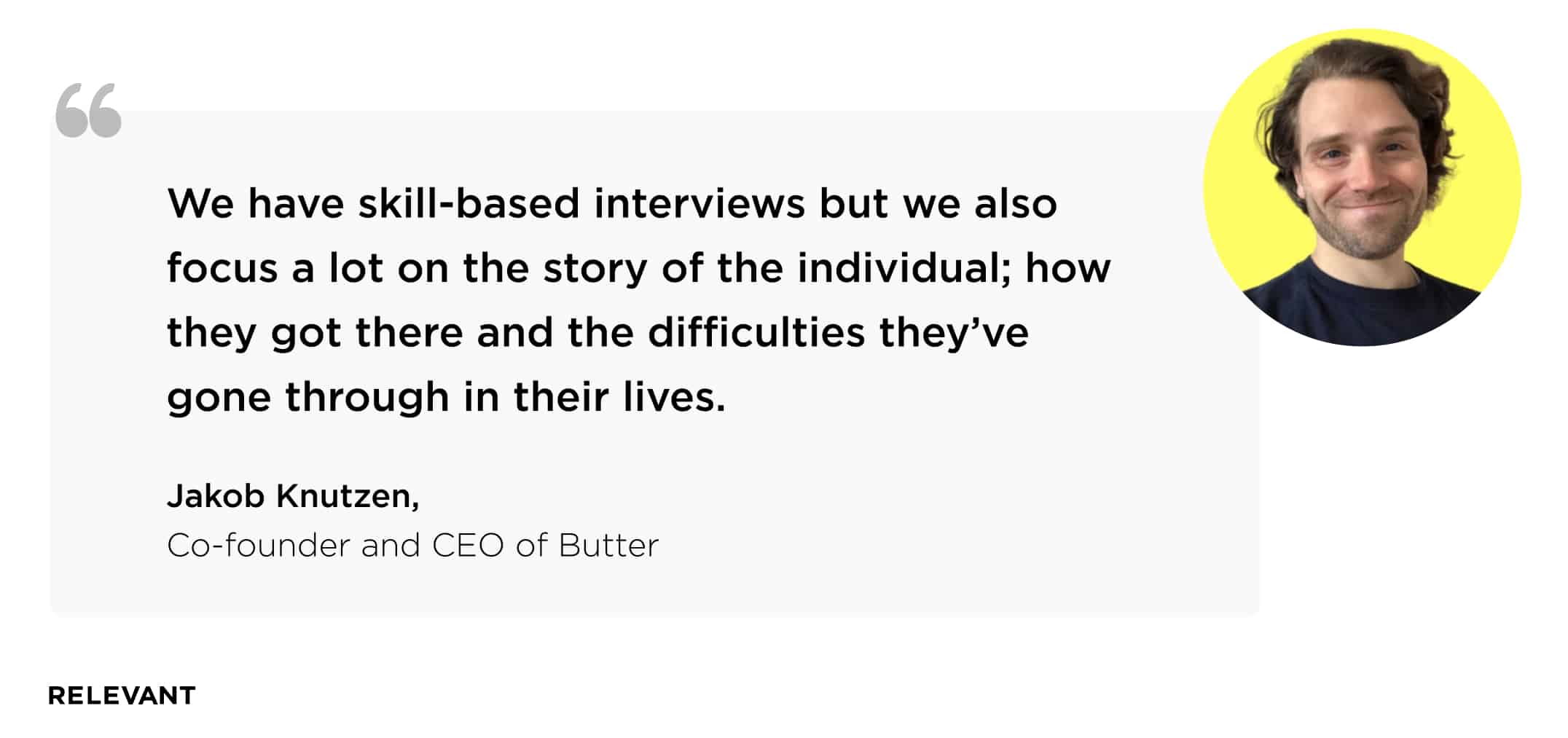
“We have skill-based interviews but we also focus a lot on the story of the individual; how they got there and the difficulties they’ve gone through in their lives. People that have gone through a lot of difficulties and are able to explain them by talking through how they plowed through the challenges are often extraordinary people compared to the straight-A students. I was a straight-A student but I have also gone through a lot of difficulties and it’s those moments that made me who I am today. It is a very rigorous recruiting process, with 5 or 6 interviews, lasting around 2 weeks, but we try to be extremely open-minded.”
Competing with big techs: How to find your specialist
“I don’t think those are the ones that are hard to compete with because they are very different people that apply for Microsoft to those wanting to work at Butter. The harder companies to compete with are the well-funded, slightly further-down-the-line startups—serious players, that provide excellent salaries and a pretty high growth trajectory. Those who apply for a startup already know the massive amount of ownership you can get from joining in the early stages. At Butter, we give equity to all of our employees, and therefore when joining the team you are taking ownership of it—making it your own.”
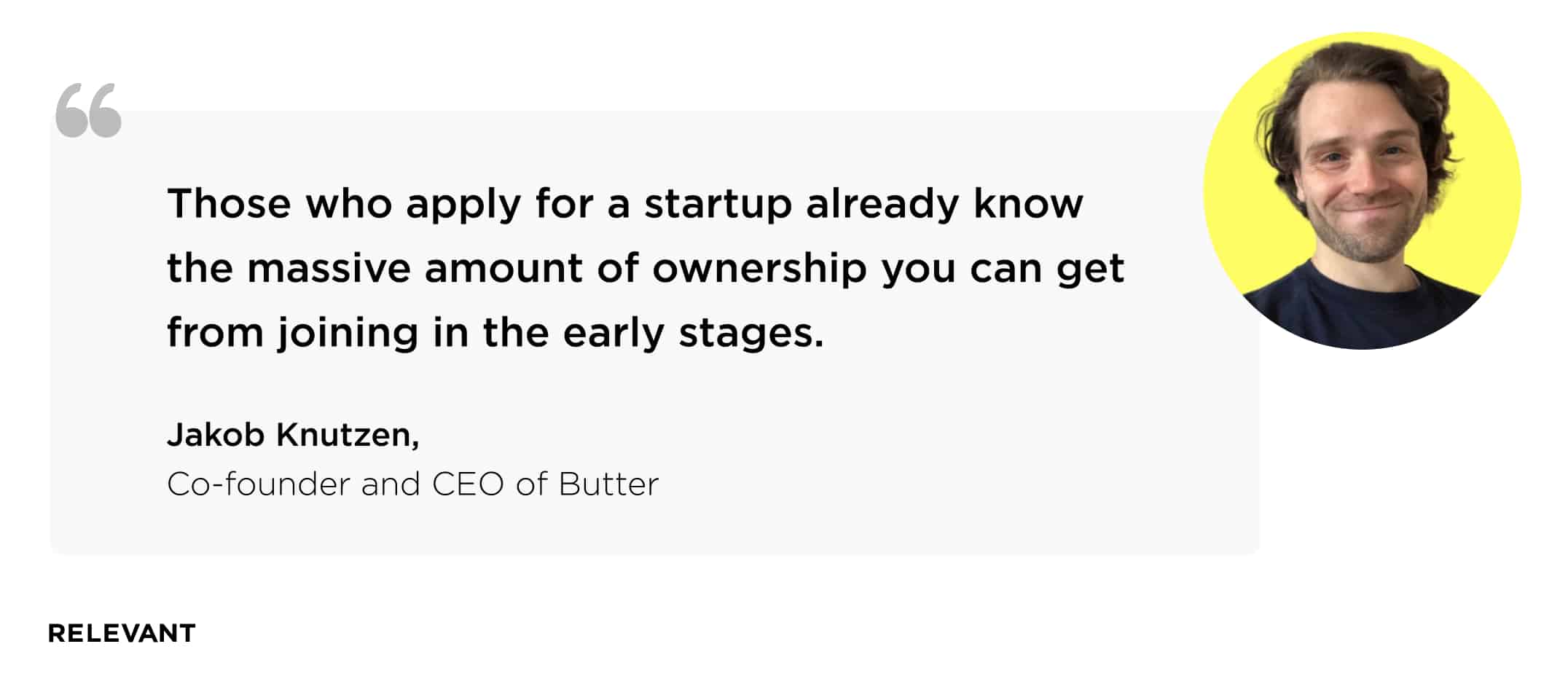
Butter initially wanted to avoid taking on interns due to the time it takes to teach this person the ropes of the company, which inherently requires more resources and effort, considering it as a ‘teaching position’. However, last year, their now backend developer showed Jakob and the team how he was ready to take on that ownership. He showed them how much he wanted the work, promising to provide value from day one.
“He managed to convince us and took on an amazing amount of work. Since then, he’s joined full time and has started taking ownership of tracking a lot of our new analytics and data structures. He’s taken on way more than you’d expect from a junior who’s only four months out of college, but it just proves that if you want to take that ownership, startups provide you with the space to do just that.”
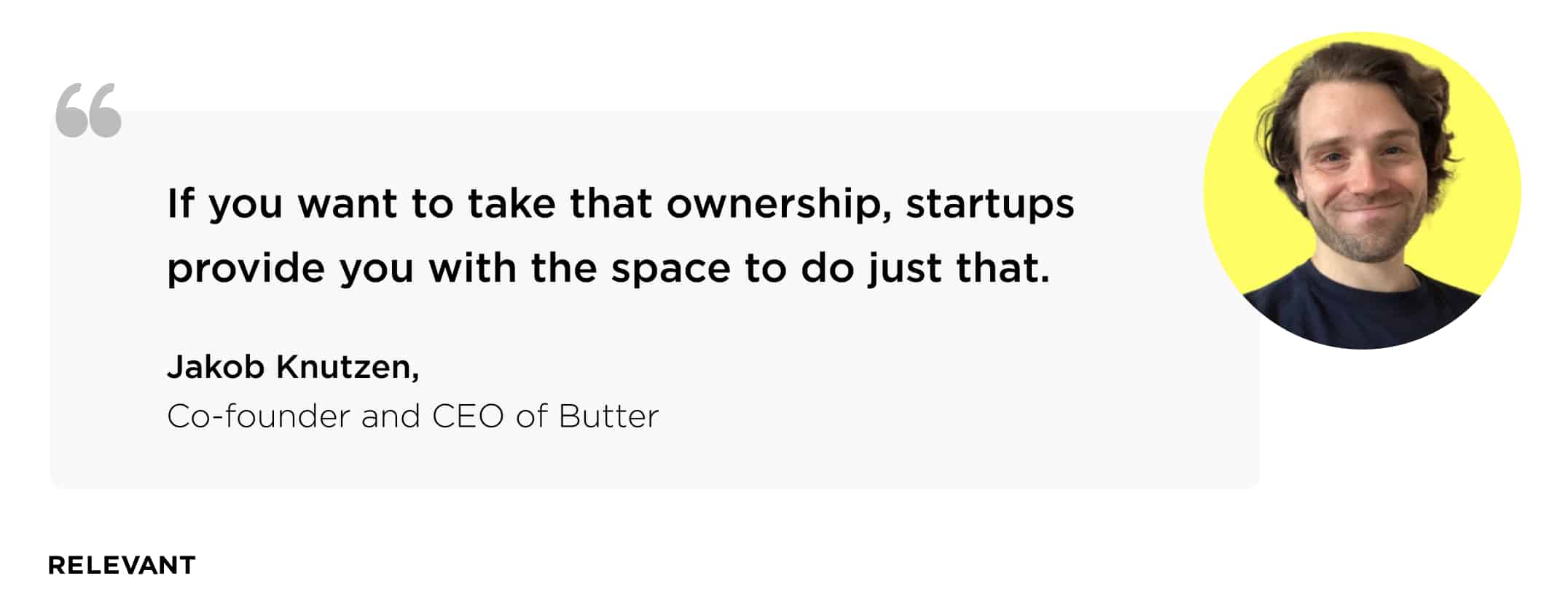
Outsourcing: Opinions, hesitations, and expectations
They, at Butter, decided not to opt for outsourcing for a handful of reasons. In the earlier days of their startup, as Jakob stressed, it was the need to have tight control over their product–often needing to do a lot of pivots, and being ready to change a numerous amount of things very fast. In such a case, Jakob believes it is often better to wait until your business has a concrete idea of its direction.
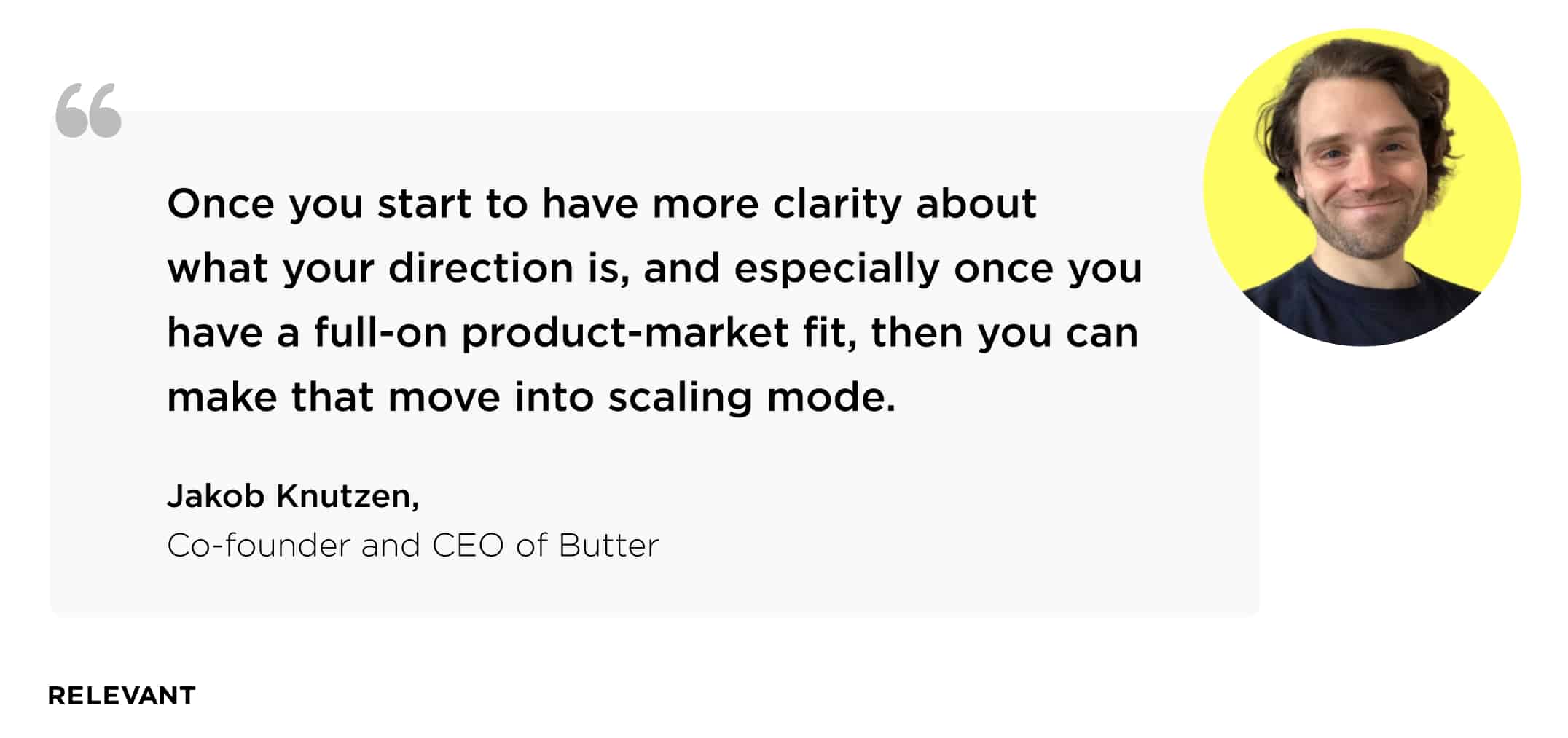
“We had a very lean team for quite some time, just six people for the first eight months, so very small. Once you start to have more clarity about what your direction is, and especially once you have a full-on product-market fit, then you can make that move into scaling mode. Once you’re into scaling mode, then having outsourced resources can help, but you need to have very clearly defined barriers about what needs to be delivered. If you cannot do that, then even having employees is dangerous. It can be quite challenging in the early days. But once you scale, it can be very powerful.
Keeping in-house or outsourcing to grow?
“Outsourcing is definitely something that I’ll consider. I think the most perfect instances of outsourcing would be clearly scoped projects that can almost run at the sidelines of your core product. The way in which it could be considered helpful is if, for example, you need a clearly delineated thing produced at the site of your product, that will then take tab in your project. In doing so, it’s a great approach because you don’t have to scale up your team resources, or your team overhead for long periods of time just for this project. That’s one way it would be very helpful.”
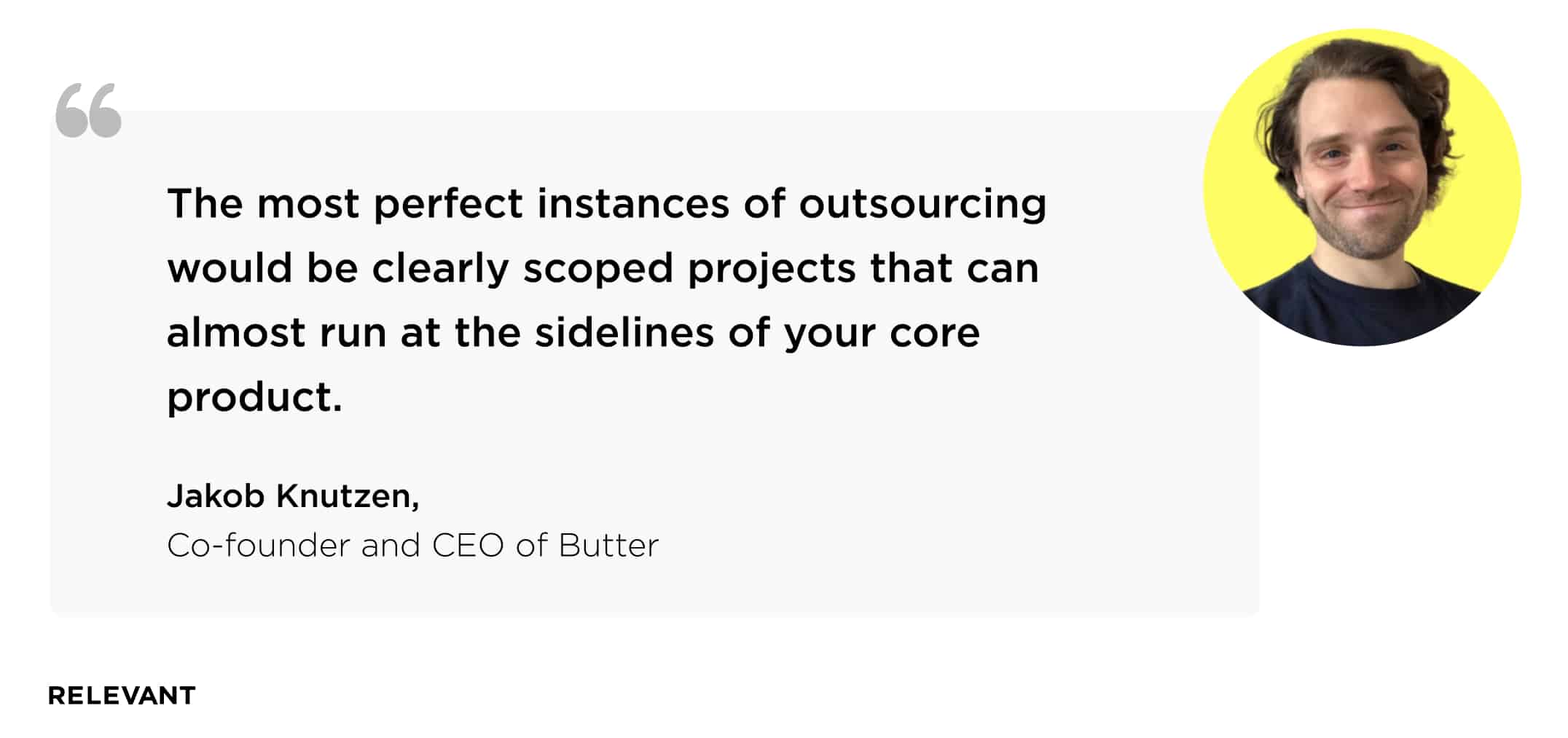
“The second way where it would be helpful is that when you’re scaling, you aren’t able to hire quickly enough. You simply cannot source your own people in time. Then it would also be an instance where I’d be interested in using outsourcing.”
Lessons of the past: Figure out what you are solving and for whom
Jakob explains that one of the biggest factors, especially compared to their previous startups, is that they are now very diligent in understanding the concrete problem needing to be solved, but at the same time, not becoming content that it’s a done deal. This has been crucial for Butter and something which was clear from as early as day zero.
“If you don’t get the problem, you will fail. There’s just no doubt. If you’re not solving a real problem, you will fail. If you fool yourself into thinking that you’re solving a problem, you will also fail. It’s about asking these questions the right way, and continuously trying to understand what the value is of what we are creating. This is central to everything.”
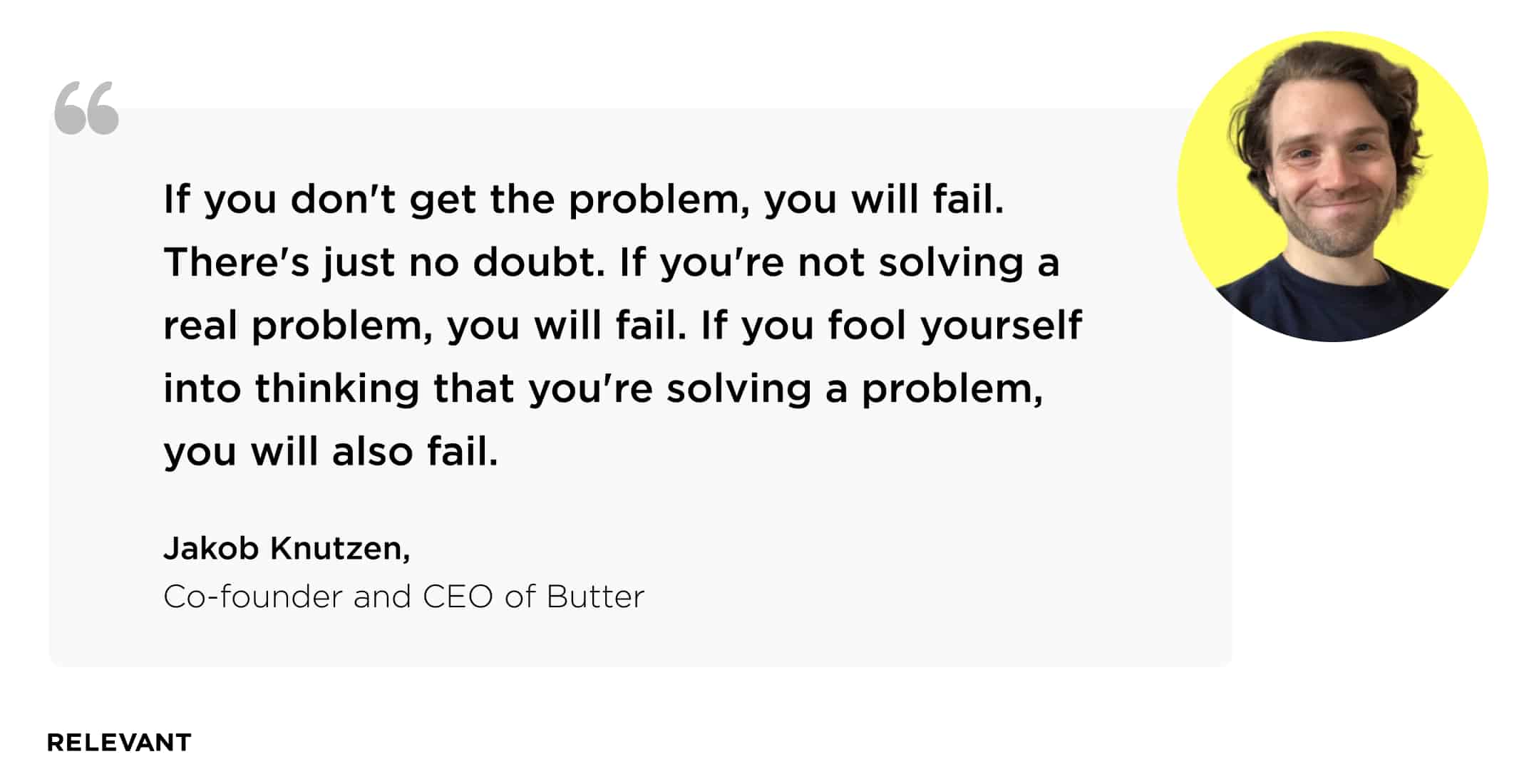
“We’re extremely focused on both customer feedback and customer interviews. During the first half of the year, I was doing between 30-50 interviews. Feedback only tells you whether you need a faster horse, whereas the customer interviews will really tell you where the car is and where it is going.”
“Even though we’re seeing quite extraordinary growth, I think it’s still very dangerous to get complacent into thinking that you’ve nailed it. It’s important to always keep your mind open about this and listen very much to your users and the market and the potential problems that you could solve.”
Challenges: Post-Covid and the return to offline learning
“I think one of the bigger challenges is probably making sure that we build extremely high-performance video tech. Many people think video is a solved problem. They think it’s just something you just plug in and then it works. But we are quite ambitious in terms of both the quality we want for our product and for the quantity, for instance, the vision of what Butter can become in terms of a tool. We’re really pushing the boundaries and putting a lot of focus on these things.”
Jakob told us how the pandemic provided Butter with additional interest from sectors such as education and teaching. They witnessed a lot of growth in areas they didn’t specifically set out to capture. However, they knew that sooner or later the pandemic will come to an end and that additional growth would drop when teaching returned offline.
“Fortunately, our initial focus on workshops, trainings, and professional B2B use cases only kept on growing even after Covid and we know remote work is definitely here to stay—remote facilitation, remote training workshops, and collaborative sessions. This highlights the importance of being very specific about your target market.”
Trends: The next stages of hybrid work
In a world where digital technology has made it easier for people to work from home, companies have been less prepared for this shift away from the office. It would be a mistake to believe returning to the same full-time in-office scenario no longer exists for many, making platforms like Butter and the products they provide more important than ever.
Jakob tells us how he rejects the idea of a hybrid workplace, convinced of the fact that hybrid work harms a team’s morale and productivity.
“I am interested in the trend of figuring out how hybrid work mode is going to run. Many people are going back to the office, but, similarly, a lot of people are staying away. People have to figure out how to work together when some people are in the office and some people are at home. I do not believe that hybrid work is a real thing.”
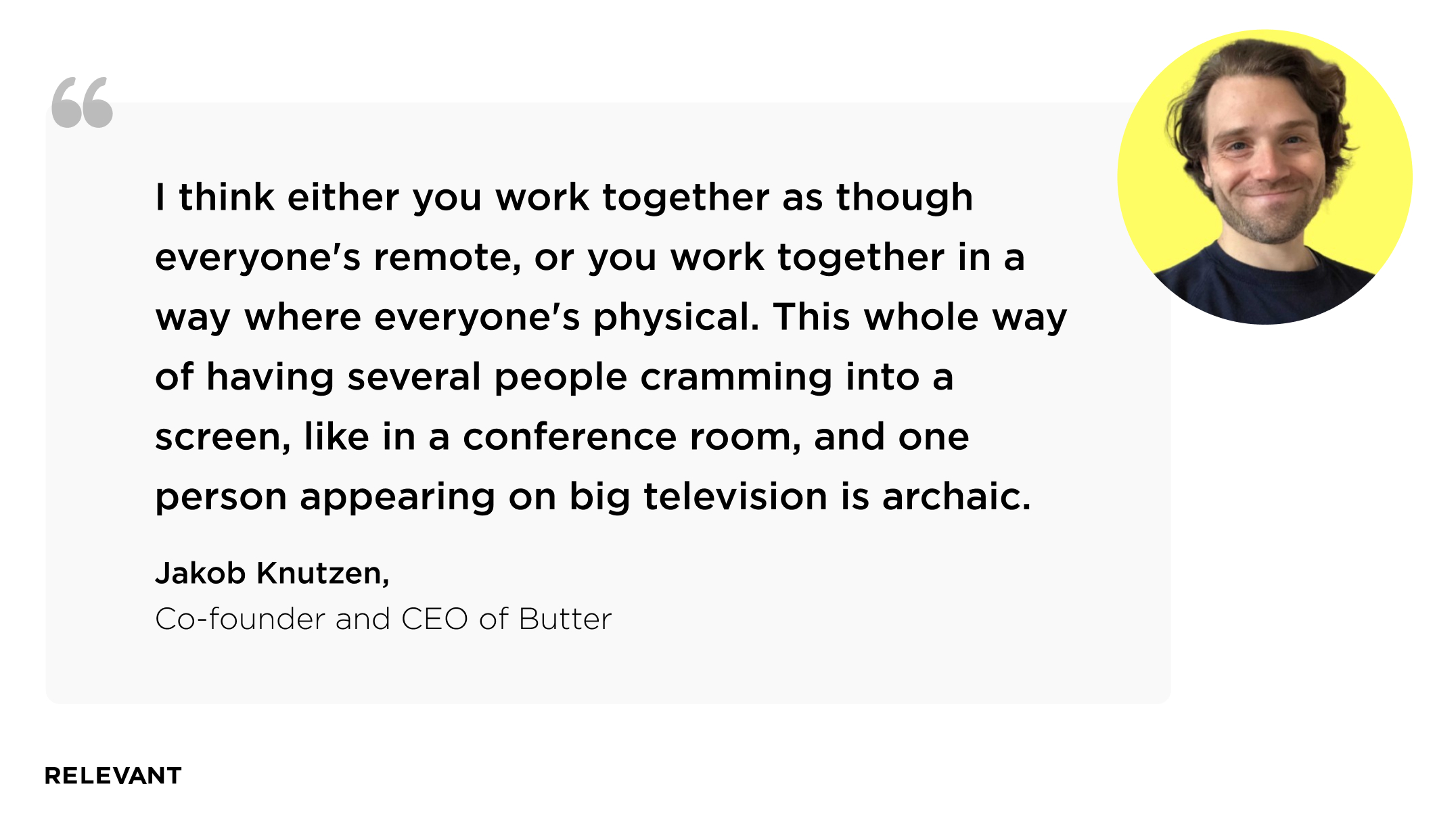
“I think either you work together as though everyone’s remote, or you work together in a way where everyone’s physical. This whole way of having several people cramming into a screen, like in a conference room, and one person appearing on big television is archaic. Employers have to figure out exactly how a team can work together in a hybrid world. A lot of people will be getting it wrong the first time around.”
Advice: The trap of fake work
“If you want to make your startup a success, I would suggest not getting fooled by fake work.”
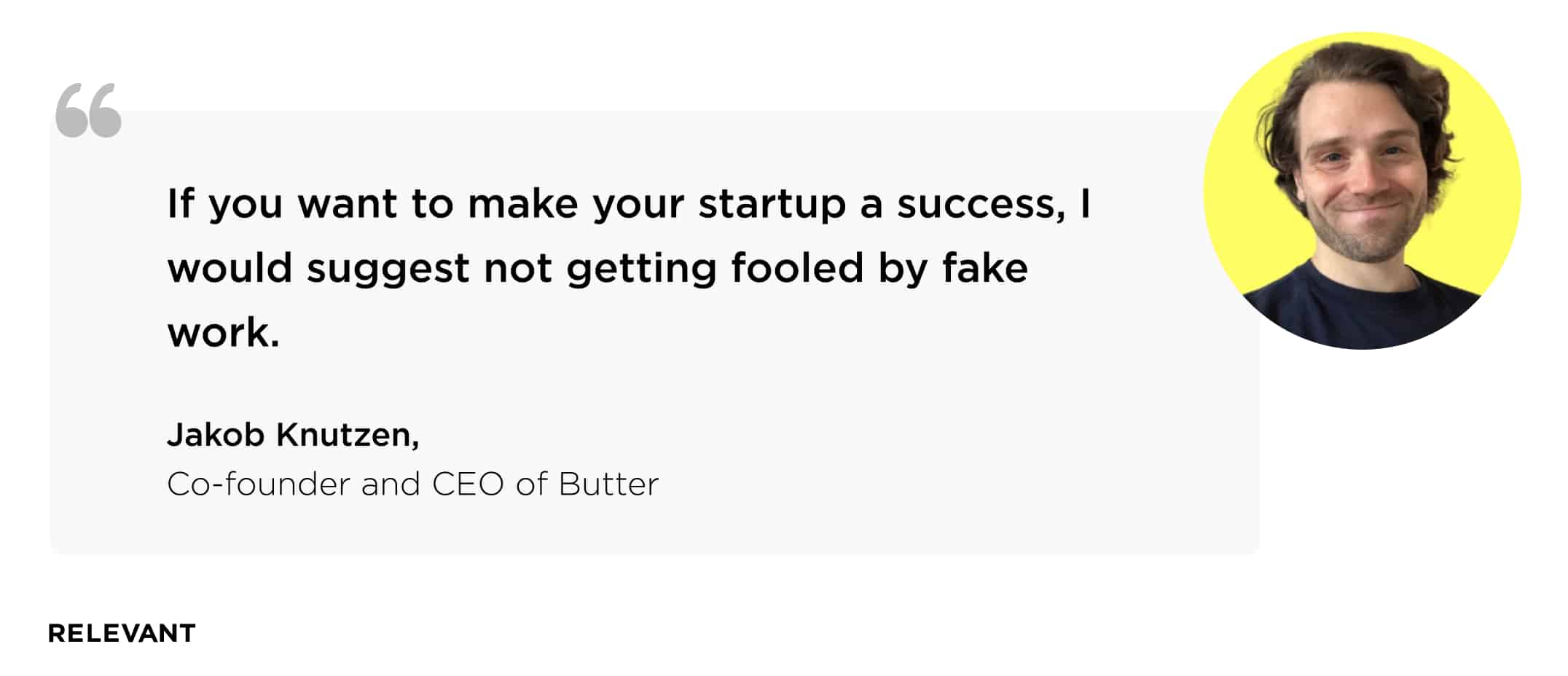
“Do not get pulled into fake work. As a startup founder, you can do so many things that feel like work, such as going to conferences or getting into a lot of analytics on a very small subset of things, or administrative tasks. These tasks seem important to you because you’re making a business, you’re building a company. But you have to be honest with yourself and ask ‘is this really moving the needle on your key metric for your startup’? Is this really driving more usage? Is it really driving more revenue? Is this really solving the problem for the user? “
“A great example of fake work would be startup competitions. That’s the ultimate fake work. It does not move any needle whatsoever to be part of or win a competition. Don’t get bogged down in things that don’t move the needle.”
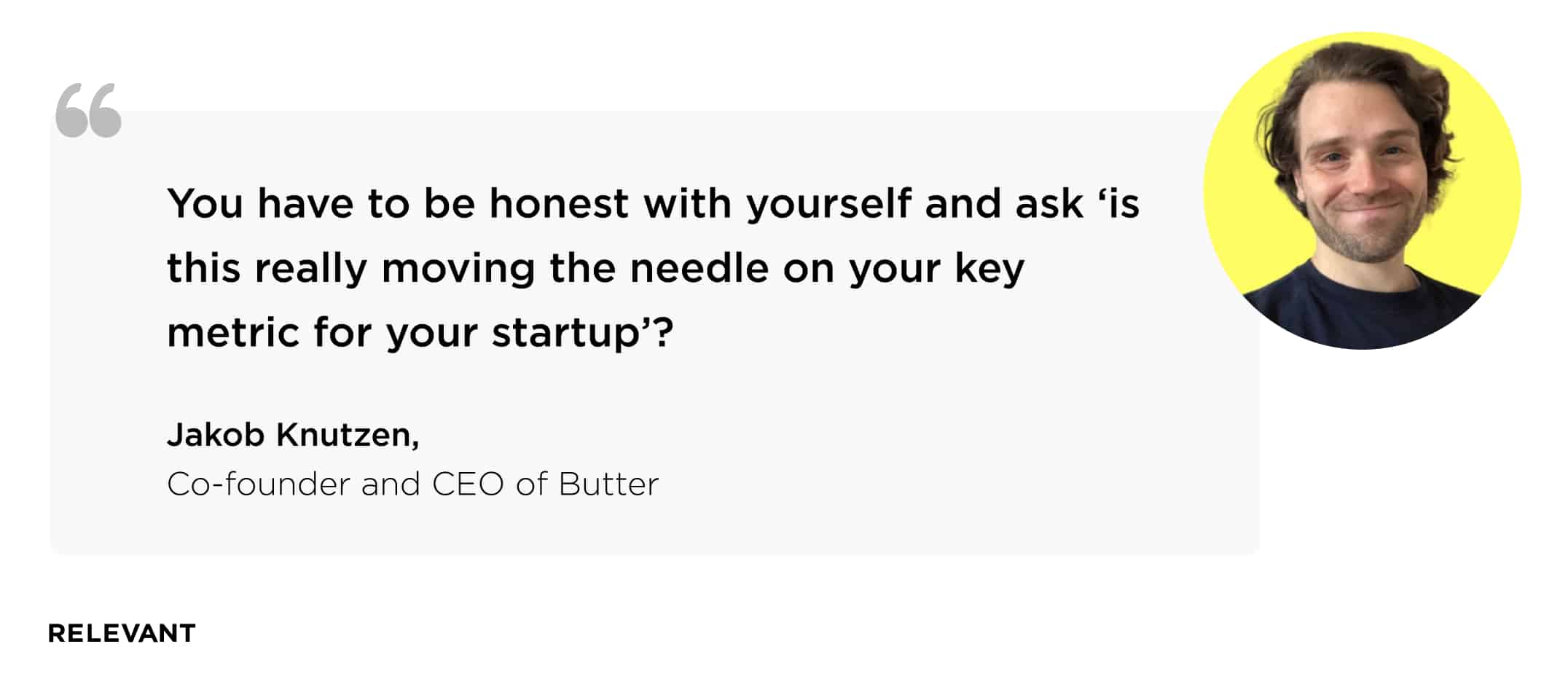
Our core services:
Do you want a price estimate for your project?
Do you know that we helped 200+ companies build web/mobile apps and scale dev teams?
Let's talk about your engineering needs.
Write to us












